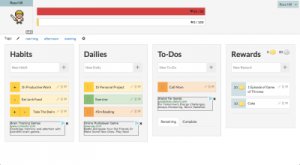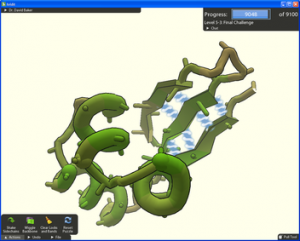The 2014 Horizon Report for Higher Education, released by the New Media Consortium and EDUCAUSE Learning Initiative, identifies trends, challenges, and technologies that they predict will have a significant impact on the short-term future of higher education. In two-to-three years, they predict, games and gamification will reach mainstream adoption.
The American Library Association defines gamification as “the process of applying game-thinking and game dynamics, which make a game fun, to the non-game context in order to engage people and solve problems.” Gamification is already widespread in non-higher-ed contexts. Because gamification can take so many forms, there are a number of organizations using it to accomplish a large range of goals.

The web application Habit RPG helps users manage their personal affairs by gamifying their to-do lists. Users have an avatar which they can level up, go on quests with, and buy equipment for. This is all accomplished using the gold and experience points they gain from “defeating” the tasks they’ve set for themselves. I’ve personally used Habit RPG to help me stay on task while editing a feature film, and it’s helped me get work done more consistently than I would have otherwise.

Foldit is a web game designed by Biology researchers at the University of Washington. Players solve spatial reasoning puzzles which are designed such that their solutions contribute to research on protein folding. The top-scoring solutions to these problems are analyzed by the university’s researchers for valuable insights into the structural configuration of real-world proteins. Most of those who play Foldit aren’t even involved in biology research! By adding an abstract gaming layer over a difficult computational problem, the researchers were able to crowd-source important contributions to the field from non-experts.
Corporations often use gamification as a marketing tool, to encourage customers to give them repeat business. Starbucks has had remarkable success with a gamified rewards system. Whenever customers use Starbucks’ rewards app to make a purchase, they’re given a gold star. After a certain number of stars, customers level up, unlocking perks like free refills, free drinks, etc. This program was a major success, with membership in the rewards program doubling from 2012 to 2013.
With the success these applications of gamification have had, it’s little wonder that educators are looking to harness it for their classes. I spoke with one of our own professors here at Simmons College, Mary Wilkins-Jordan, about her experiences using gamification in an academic course.
In the summer of 2013, Wilkins-Jordan was teaching three online LIS classes: “Management,” “Reference”, and “Management in Public Libraries”. She had just read Jane McGonigal’s book on gamification, Reality is Broken, and it had inspired her to action. She decided to unify her three classes by introducing an original Alternate Reality Game (ARG) titled “Saving Kingston”.
At the very beginning of the summer session, along with their syllabi, students received a cryptic email introducing Kingston, a New England town which was having some trouble keeping corporeal. The city was constantly vanishing and appearing at different points in space-time. This being very bad for business, tourism, and peace of mind, the town decided to hire some LIS contractors to tighten up their epistemological/ontological standing. Wilkins-Jordan’s students were to take the role of the contractors, improving the city’s LIS capabilities to help it maintain its reference points.
We all hope they can help us; they only have until Aug 2 to accomplish everything. Otherwise we disappear – possibly forever! #SaveKingston
— City of Kingston (@SavingKingston) June 2, 2013
In order to integrate three separate classes into one ARG, Wilkins-Jordan created a fourth course page on Moodle (the main SLIS LMS) specifically for the game. Students visiting the page were greeted with a representation of the town with various locations that could be visited and NPCs which could be interacted with. Kingston’s accessible locations included examples of most major types of library, and when students requested more (e.g. a correctional facility library and an art museum library) Wilkins-Jordan added them. Students visiting Kingston’s libraries found them completely disorganized and poorly run. There were staff lists, budget write-ups, disaster plans, and other organizational documents available, but they betrayed an unfortunate lack of competence. As the city’s new LIS contractors, students were able to join an organization that aligned with their career goals and endeavor to improve their functioning. Such was the game’s goal: to elevate these organizations enough to level them up from Aluminum to Platinum by the end of the summer session.

Wilkins-Jordan had some lofty goals when she began this ARG. First off, she wanted to encourage personal interaction between students, a factor that is all too often lacking in online courses. To this end, she equipped the ARG moodle with many discussion boards for every aspect of the game. She encouraged students to use them by decreeing that she would not answer any questions until they had first been posed to other students on a discussion board. Additionally, she incorporated teams into the game—each organization in Kingston needed multiple students on board, handling different leadership roles according to which of the three courses they were enrolled in. This aspect of the course was a resounding success. Students were not only interacting via the discussion boards, they were also emailing, collaborating through Google Docs, and even video chatting. The game fostered relationships more memorable than most online courses.
Another main goal of the game was to foster creativity. In his article “Games, Gamification, and the Quest for Learner Engagement”, Karl M. Kapp argues that games which allow for frequent, low-consequence failure encourage learners to “explore the content, take chances with their decision making, and be exposed to realistic consequences for making a wrong or poor decision.” Saving Kingston made use of this principle by including a large number of low-stakes tasks with built-in feedback and revision. This allowed students to be creative in their work and modify their approaches on the fly based on peer responses.

Lastly, Wilkins-Jordan hoped her game would bring about a high level of self-motivation in her students. To this end, she did not make playing the game fully mandatory (though the syllabi did state that students who participated were more likely to receive an A). Because the game allowed for a choice in whether or not to fully participate, students felt more ownership over their participation. All students were given instructor privileges, allowing them to edit the ARG’s moodle to add locations and NPCs to the game, further increasing their ownership over it. The fantasy storyline, the incremental leveling up, and the peer interaction all contributed to a sense of fun that kept students going. In the end there was 100% participation in the game, and many students continued playing until the end, even after they’d already reached their personal goals.
Wilkins-Jordan admitted that running the ARG added a lot of time and effort on top of her usual course preparation, but for her it was worth it. She enjoyed running the game, and plans to try another course ARG in the future. Some of the course’s students were outspoken in their enjoyment of the course, as seen in this series of blog posts by Julie Steenson.
Mary Wilkins-Jordan is not the only LIS educator experimenting with gamification. The Syracuse University iSchool’s Scott Nicholson runs the Because Play Matters Game Lab, which studies the ways that games can support education. At Purdue University, educators are using a new Learning Management System called Passport which awards students with virtual badges for accomplishing academic achievements. At the University of Michigan’s School of Information, Professor Cliff Lampe uses role playing and game-based tasks in his introductory courses. It’s clear that there’s a trend forming, and it will be interesting to see the direction it takes in the next few years.
(Post by Derek Murphy)